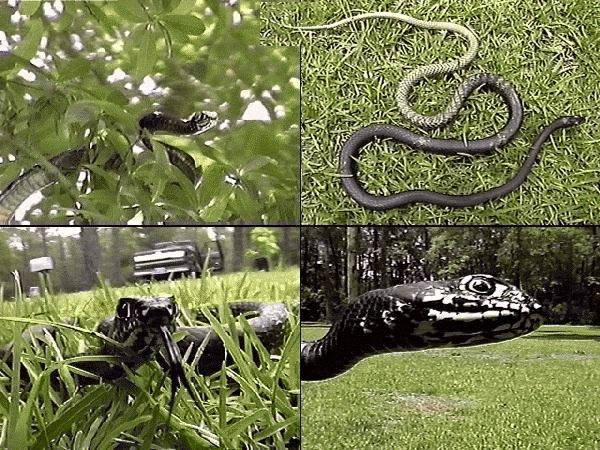
Family: Colubridae - Harmless Egg-Laying Snakes
Typical Adult Size: 42 to 60 inches
Eye Pupil: round
Dorsal Scales: smooth
Anal Scale: divided
Eastern Coachwhip Snake Masticophis flagellum flagellum
|
|
Family: Colubridae - Harmless Egg-Laying Snakes Typical Adult Size: 42 to 60 inches Eye Pupil: round Dorsal Scales: smooth Anal Scale: divided |
The Eastern Coachwhip is a very impressive snake. They are long, slim snakes. It is our only species of snake in which the coloration varies substantially in the linear direction, that is, from from head to tail. The head and first half or so of the body is usually charcoal black. The black transitions from black to tan for the remainder of the body and tail. The tan scales are outlined in black. The overall appearance is that of a whip.
Coachwhips are not constrictors. They grasp prey in their mouth and hold on. Sometimes they pin the prey to the ground by using a loop of the forebody. They often travel with the head held well off the ground. Their eyes are located in a more forward-looking position than most other snakes. This gives them a raptor-like visage.
Many adult specimens are of 4 to 5 foot in length. However, much longer specimens in the 7 to 8 foot range can be found. The longest official record is often listed as being approximately 8.5 feet.
In many ways the Coachwhip resembles and behaves like the more common Black Racer. Coachwhips have historically populated most of South Carolina, except the mountains and high foothills. They are still well represented in the Sandhills and Coastal Plains areas of the state. However, their populations in the Piedmont seem to have been seriously depleted. When I was a young herper in the late 50s and 60s, I could commonly find Coachwhips in Laurens County where I lived. Many specimens were quite large, over six feet. Unfortunately, the last specimen I have seen in the Piedmont was a DOR in 1990. A colleague, who is also an avid herper, reported finding a DOR specimen in Laurens County in May 2004. He said this was only the third Coachwhip he has ever found in Laurens County.
While my son, Win, was growing up, I always wanted to show him a wild Coachwhip but never did find one. After I revived my interests in herping in 1995 and started the South Carolina Reptiles and Amphibians website, Win and I took a herping daytrip to the Aiken State Natural Area in the Sandhills of SC. One of the species we hoped to find was a Coachwhip. To our pleasant surprise, we found one. We spotted it as we drove down a service road. The day was hot and clear. Six-lined Racerunner Lizards were scampering about. The snake took refuge in a tree. Fortunately for us, the area consisted of sparsely-spaced, scrub oaks. We could clearly see the snake in the tree and it had nowhere to go but down.
We contemplated what to do. Win decided to wait the snake out. I went on down the road searching for other herps. When I returned about 30 minutes later, Win had the Coachwhip in his hands. Win had waited motionlessly in the shade at the trunk of the small tree. Cautiously the snake began to decend. Win slowly extended his stick above his head along the trunk. The snake reached his stick and then began crawling down it. It reached his hand, flicked its tongue a few times and then began to retreat. At this point he grabbed the snake.
Additional Images:| Eastern Coachwhip Snake, Masticophis flagellum flagellum |
| adult, in tree |
July 07, 2009
Contact: South Carolina Reptiles and Amphibians